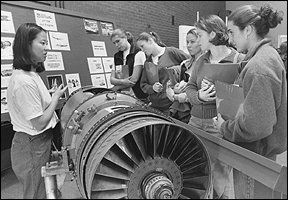![]()
Departments
![]()

|
Week of 17 April 1998 |
Vol. I, No. 28 |
Feature
Article
Student engineering group flying high
Aeronautics and astronautics students win award
by Brian Fitzgerald
Jennifer Chu (ENG'98) was delighted when she found out that the BU student chapter of the American Institute of Aeronautics and Astronautics (AIAA) was selected "best in the Northeast" this year by the national technical society.
She was told the news during AIAA's student regional conference in Buffalo, N.Y., on April 3. "It was an interesting event," she says of the annual meeting of future aeronautics and aerospace engineers. "The conferences give us a chance to check out the technical research at other colleges and to see what AIAA's student chapters are doing."
|
|
|
At Pathways '98, Boston
University's fifth annual program for young women
interested in science, mathematics, and
engineering, Jennifer Chu (ENG'98) (left), a member
of the BU student chapter of the American Institute
of Aeronautics and Astronautics, shows a
refurbished jet engine to Massachusetts high school
students (from left) Abbey Stella, Adrianne
Morrell, and Lisa Zabielski, from Westfield High,
along with Silver Lake Regional High students Mary
Cunningham and Jill Donnelly. Photo by Kalman Zabarsky
|
BU's AIAA branch also sponsors lectures by engineers from national and local corporations, and visits such locations as Sikorski Aircraft in Stratford, Conn., and Hanscom Air Force Base in Bedford, Mass. In addition, these BU aeronautics and astronautics majors have built several remote-controlled model airplanes, and last year refurbished a jet engine that was donated by Pratt & Whitney Canada.
On April 14 and 15, Chu proudly displayed the JT 12A jet engine at Pathways '98, Boston University's fifth annual program for young women interested in science, mathematics, and engineering. "Pathways is a fantastic way to get women interested in these fields," she says. The high school students were fascinated by the six-foot-long engine.
"Nationally, the number of women in college engineering programs is very low -- 18 to 20 percent," says Chu. "At BU, the ratio is better: 30 percent of engineering majors here are female. And Pathways is a great promotion. Our group is proud to be a part of it."
Chu, who will work for Pratt & Whitney in East Hartford, Conn., after she graduates, says that it makes sense for aeronautics and astronautics students to be involved in the same extracurricular group at BU.
"Aeronautical engineering typically deals specifically with aircraft and aeronautics," she says, "and astronautical engineers traditionally work with spacecraft and astronautics, but as technology advances, these fields are merging." She points out that two major NASA projects blend technology from both fields: the space shuttle and the X-33. A test vehicle of the latter, designed to be launched vertically as a rocket and land horizontally like a plane, will be completed by Lockheed-Martin next March.
"The AIAA provides a useful forum for the exchange of technical research," says faculty advisor Sheryl Grace, an assistant professor of aerospace and mechanical engineering. "The students receive feedback on their design projects and share ideas."
